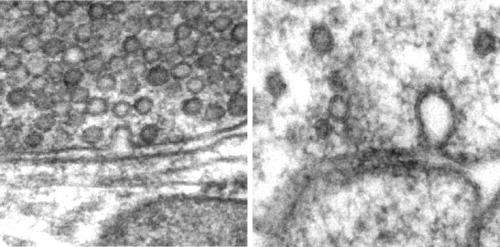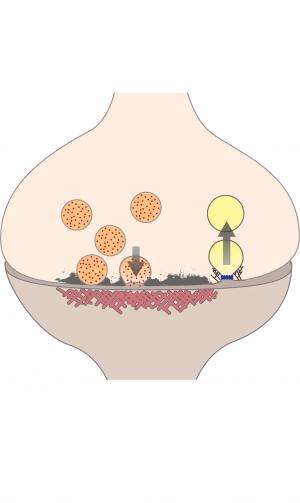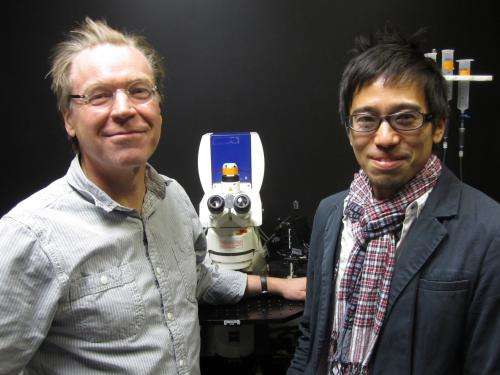How our nerves keep firing: Biologists see ultrafast recycling of neurotransmitter-filled bubbles

University of Utah and German biologists discovered how nerve cells recycle tiny bubbles or "vesicles" that send chemical nerve signals from one cell to the next. The process is much faster and different than two previously proposed mechanisms for recycling the bubbles.
Researchers photographed mouse brain cells using an electron microscope after flash-freezing the cells in the act of firing nerve signals. That showed the tiny vesicles are recycled to form new bubbles only one-tenth of a second after they dump their cargo of neurotransmitters into the gap or "synapse" between two nerve cells or neurons.
"Without recycling these containers or 'synaptic vesicles' filled with neurotransmitters, you could move once and stop, think one thought and stop, take one step and stop, and speak one word and stop," says University of Utah biologist Erik Jorgensen, senior author of the study in the Dec. 4 issue of the journal Nature.
"A fast nervous system allows you to think and move. Recycling synaptic vesicles allows your brain and muscles to keep working longer than a couple of seconds," says Jorgensen, a distinguished professor of biology. "This process also may protect neurons from neurodegenerative diseases like Lou Gehrig's disease and Alzheimer's. So understanding the process may give us insights into treatments someday."
A brain cell maintains a supply of 300 to 400 vesicles to send chemical nerve signals, using up to several hundred per second to release neurotransmitters, says the study's first author, postdoctoral fellow Shigeki Watanabe.
Recycling vesicles is called "endocytosis." Jorgensen and Watanabe named the process they observed "ultrafast endocytosis." They showed it takes one-tenth of a second for a vesicle to be recycled, and such recycling occurs on the edge of "active zone" – the place on the end of the nerve cell where the vesicles first unload neurotransmitters into the synapse between brain cells.
"It's like Whac-A-Mole: one vesicle goes down (fuses and unloads) and another pops up someplace else," Jorgensen says.
Jorgensen believes ultrafast endocytosis is the most common way of recycling vesicles, but says the study doesn't disprove two other, long-debated hypotheses:
- "Kiss-and-run endocytosis," which supposedly takes one second, with a vesicle just "kissing" the inside of its nerve cell, dumping its neurotransmitters outside and "running" by detaching to reform a recycled vesicle in the same part of the active zone.
- Clathrin-mediated endocytosis," which purportedly takes 20 seconds and occurs away from the active zone, at a point where a protein named clathrin assembles itself into a soccer-ball-shaped scaffold that forms a new vesicle or bubble.
Earlier this year, Jorgensen, Watanabe and colleagues published a related study in the journal eLife revealing that ultrafast endocytosis occurs in nematode worms. The new study of hippocampal brain cells from mice "tells us that mammals – and thus humans – do it the same way," Jorgensen says. "The two papers together identify a process never previously seen – much faster than has been measured before."
Jorgensen and Watanabe conducted the study with M. Wayne Davis, a University of Utah research assistant professor of biology; and technician Berit Söhl-Kielczynski and neuroscientists Christian Rosenmund, Benjamin Rost and Marcial Camacho-Pérez, all of Germany's Charity University Medicine Berlin.
The study was funded by the National Institutes of Health, the European Research Council and the German Research Council. Jorgensen also is funded by his status as a Howard Hughes Medical Institute investigator and an Alexander von Humboldt Scholar.

Machine Gun Analogy for Vesicle Recycling
The process of a vesicle fusing to the nerve cell's wall from the inside, then releasing neurotransmitters into the synapse is known as "exocytosis." An analogy might be a bubble rising from boiling soup and releasing steam. The liquid part of the bubble fuses with the liquid in the soup, sooner or later to arise in another bubble.
The 2013 Nobel Prize in Physiology or Medicine went to three scientists who discovered key aspects of vesicle transport of cargo and exocytosis in nerve and other cells: which genes are required for vesicle transport, how vesicles deliver cargo to the correct locations, and how vesicles in brain cells release neurotransmitters to send a signal to the next brain neuron.
Jorgensen, Shigeki and colleagues studied the next step, endocytosis: how the membrane that forms vesicles (and nerve cell walls) is recycled to form new vesicles.
To illustrate the three possible mechanisms for recycling vesicles, Jorgensen compares vesicles with machine gun shells.
"You are fusing vesicles to the nerve cell membrane and expelling the neurotransmitter contents at extremely high rates," he says. "The synapse will use up its 'ammo' very quickly at these rates, so the cell needs to refill the empty shells."
Clathrin-mediated vesicle recycling is like "remaking the shell from scratch," he says, while kiss-and-run endocytosis is like picking up every empty shell casing and refilling them one at a time.
"Ultrafast endocytosis allows the synapse to whip up all of the empty shells by the handful, fill them, and put them back in line at incredibly fast rates so the machine gun never runs out of ammo," Jorgensen says.

Flash and Freeze for Nerve Cells in Action
Shigeki, Jorgensen and colleagues developed a method to photograph the tiny vesicles inside a nerve cell as the bubbles moved to the end of the cell, fused with the cell membrane, dumped their load of neurotransmitters into the gap or "synapse" between nerve cells, and then were recycled to reappear as new bubbles inside the nerve cell.
"We found a way to look at this process on a timescale that no one ever looked at before," Watanabe says.
First, the researchers grew hundreds of brain cells from the mouse hippocampus – the often-studied part of the brain required for memory formation – on quarter-inch-wide sapphire disks placed in petri dishes with growth medium.
They added an algae gene to mouse brain cells that made the neurons produce an "ion channel" – basically a switch – that is stimulated by light instead of electricity. Then the brain cells were placed in a super-cold, high-pressure chamber, at 310 degrees below zero Fahrenheit and pressure 2,000 times greater than Earth's atmosphere at sea level.
A wire cannot be routed into the chamber, which is why the cells were genetically programmed to be stimulated by light. The researchers flashed blue light on the mouse brain cells, making them "fire" neurotransmitter nerve signals. At the same time, the firing neurons were frozen with a blast of liquid nitrogen. To catch neurons in all stages of firing, the nerve cells were frozen at various times after the flash of blue light: 15, 30 and 100 milliseconds and one, three and 10 seconds.
"We built a new device to capture neurons performing fast behaviors," Jorgensen says. "It stops all motion in the cell – even membranes in the act of fusing.
"We call it flash and freeze," Watanabe says.
Next, the sapphire disks with neurons were put into liquid epoxy, which hardened and then were thin-sliced so the neurons could be photographed under an electron microscope. The ultrafast formation of recycled vesicles was visible.
"You see the outline of the membrane," Jorgensen says. "You see the bubbles or vesicles in different stages of formation."
Watanabe says about 3,000 mouse brain cell synapses were flashed, frozen and analyzed during the study. About 20 percent of the nerve cells had been fired and showed signs that nerve vesicles were being recycled.
More information: Ultrafast endocytosis at mouse hippocampal synapses, Nature, DOI: 10.1038/nature12809



















